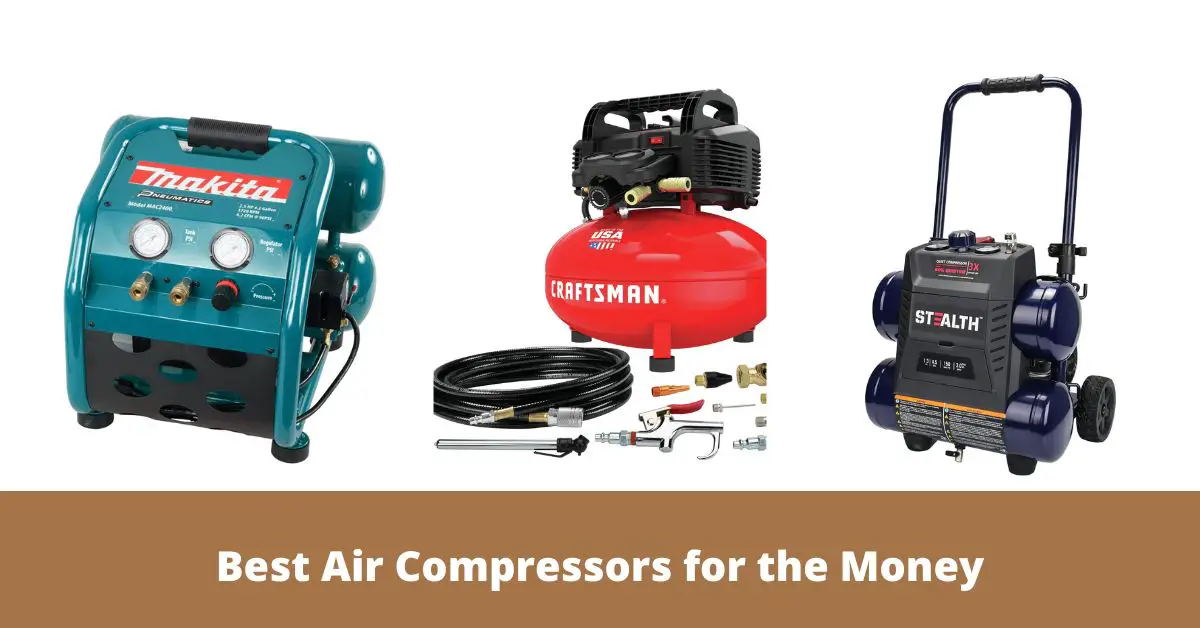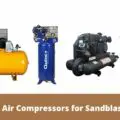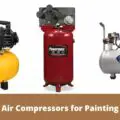Air Compressors
Best Air Compressors for the Money
Best Air Compressors for the Money
Air compressors are a must-have for anyone wishing to operate a pneumatic tool. Whether it’s a nail gun, a pavement breaker, or anything in between, you need the right air compressor to operate it effectively.
How do you qualify the best air compressors for the money? Is it the size that matters most, or should you focus on the air output to get the best compressor for the job?
In my experience, the latter rings true. When it comes to air compressors, bigger doesn’t always mean better. In fact, size doesn’t normally factor into the decision unless portability is a desired attribute.
If that’s the case, what should you focus on when comparing air compressors?
The CFM Rating
In lieu of physical size, my favorite spec to focus on when looking at air compressors is the CFM rating.
CFM stands for Cubic Feet per Minute. It is the standard measure of the air delivery rate of an air compressor. Air compressors for pneumatic tools generally have air delivery rates in the region of 10 – 110 CFM.
Those with lower CFM ratings work well for small tools like pneumatic nail guns, sanders, and chippers. They can also serve as excellent tire inflators.
You’ll find compressors made for industrial applications in the higher CFM range. These work with heavy-duty pneumatic equipment like jackhammers and impact wrenches.
To help you narrow down your choices, you can categorize air compressors like this:
<10 CFM: Suitable for portable pneumatic tools such as nail guns, angle grinders, air hammers, and pneumatic chisels.
10 – 30 CFM: Suitable for cutting tools with spinning discs. Also recommended for dual sanders, needle scalers, aerosol spray cans, and air shears.
30 – 60 CFM: Suitable for impact wrenches, ratchets, drills, and vertical grinders. It might be required by heavy-duty air hammers.
60 – 110 CFM: Suitable for industrial applications like breaking pavement. Necessary for tools like jackhammers and impact drills.
This classification method serves me well as a reference guide when shopping for air compressors. If you’re interested in creating your own shopping criteria, I recommend you start by:
Checking the CFM requirements of your most demanding tools.
Combine the CFM requirements of the tools you use simultaneously to get an accurate estimate of total air consumption.
Check the compressor’s duty cycle; make sure it is 100%. Many compressors are rated based on 50% or 60% duty cycles, so they may require you to stop several times (for refills).
Other Factors to Consider When Buying Air Compressors
Rotary Screw vs. Reciprocating
There are two types of air compressing mechanisms, and it’s pretty clear that one is more efficient than the other.
The rotary vane compression mechanism compresses air by trapping it between two meshing helical screws turning in opposite directions.
In contrast, reciprocating (piston) compressors are driven by crankshafts that push pistons up and down in the cylinder to create compression.
As a result of these varying mechanisms, air compressors can have vastly different performances. Piston compressors generally cost more to run because they rely on air receiver tanks to achieve a 100% duty cycle. Remember, these must be purchased separately.
Rotary screw compressors are clearly better. They are far more energy efficient, cost less to maintain, produce higher air quality, and are more durable. They easily reach 100% duty cycle without necessitating a receiver tank. What’s more, some of them can be super quiet.
Portability
There are some lightweight air compressors out there, and by lightweight, I mean about 36 pounds, which is still considerable heft. If you need to work at distant locations, weight should definitely be a consideration.
Some air compressors easily weigh over 1,000 pounds, and that’s quite modest. They are typically very heavy, and most that seek them out don’t necessarily worry about portability as it’s one of the trade-offs for higher CFM ratings.
Luckily, most compressors come with enhanced mobility features. I’ve seen handheld ones, owned a couple of tow-behinds, and once rented a vehicle-integrated air compressor, so they’re usually designed to move easier due to their weight.
Power Source
For the most part, I’ve had a lot of luck with electric air compressors. They’re fairly affordable, run on clean energy, and may even surprise you by being quieter than you expect.
Venture to industrial settings, and you’ll spot gas-powered compressors, hydraulic compressors, and even diesel workhorses with extremely high CFM ratings. Of course, they come with matching price tags and are typically used in large job sites.
Great Air Compressors from Amazon
If you’re in a hurry, I recommend checking out some of these Amazon air compressors. You can get decent deals as long as you know what to look for.
Makita MAC2400 2.5HP Air Compressor
I’d recommend this as a solid air compressor for low-level pneumatic tools. It runs on a 2.5HP electric motor that produces up to 4.2 CFM @ 90 PSI and 4.8 CFM @ 40 PSI.
For nail guns, sanders, air hammers, and angle grinders for wood, it’s as reliable as it gets. It can run two nail guns simultaneously, and its motor runs surprisingly quiet (around 78 decibels) due to its lower RPM.
It’s built inside a sturdy metal roll cage, so it’s job site-ready and resilient. The 4.2-gallon receiver tank is not too small for a day of moderate work.
Stealth Ultra Quiet Air Compressor
Running at 64 decibels at 100% cycle duty, this is one of the quietest air compressors available. It runs on an oil-free air pump powered by a 1.3HP induction electric motor, which is why it can achieve 3 CFM @ 90 PSI. However, it can also run at 150 PSI.
Built onto a wheeled platform, it’s one of the most portable air compressors I’ve ever seen. It comes with a collapsible handle, an upright roller, and 5-inch rubber wheels, making it very portable.
Craftsman Air Compressor
Perhaps you’re looking for a piston compressor with slightly more capacity. In that case, I’d recommend this 6-gallon Craftsman air compressor.
Even though it delivers only 2.6 CFM @ 90 PSI, it has a quick recovery time that significantly minimizes downtimes. However, those aren’t too frequent, as its air tank is adequate for most domestic applications.
It weighs just over 32 pounds, so its overhead handle is more than enough to make it perfectly portable.
Why You Should Trust Us
At Woodworking Tool Guide, we know one size doesn't fit all! We cater to every woodworker, from beginner to pro, with insights and recommendations tailored to your skill level, project needs, and budget. We take the guesswork out of choosing the right tools, whether you're tackling your first crafting a masterpiece for the ages. So grab your chisel, join our community, and let's build something amazing together!
Woodworking Tool Guide wasn't just born, it sprouted from a seed of passion for the craft. What started as a joyful exploration blossomed into a trusted online haven for fellow enthusiasts like you. We pour our love into meticulously chosen review selections, meticulous hands-on testing, and lab-backed insights, all to empower you with reliable, comprehensive information you can build on. So, grab your tools, trust our guidance, and let's build something beautiful together!
Passion-Driven Expertise
Our journey started with a shared love for woodworking. The team behind the Woodworking Tool Guide is comprised of individuals who are not just writers but passionate woodworkers themselves. This shared enthusiasm ensures that our content is crafted with a deep understanding of the craft and an authentic appreciation for quality tools.
Top Tool Guides Online
Woodworking Tool Guide has rapidly ascended to become one of the premier online destinations for tool guidance. Our commitment to excellence and the accuracy of our information has positioned us as a reliable source for both beginners and seasoned woodworkers seeking trustworthy advice on the best tools for their projects.
User-Centric Approach
Our content caters to every woodworker, from rookies just starting out to seasoned pros tackling intricate projects. We tailor our insights and recommendations to your skill level, project needs, and budget, ensuring you find the perfect tools to match your unique woodworking journey. So step into your workshop, grab your tool belt, and let Woodworking Tool Guide be your trusted companion as you craft your masterpieces.
Continuous Support and Innovation
Woodworking is an ever-evolving craft, and so is our commitment to supporting you. We are dedicated to bringing you the latest information on woodworking tools, techniques, and trends. Our team is actively working to expand our content and bring you more valuable insights, ensuring that you stay well-informed in your woodworking adventure.
Hands-On Experience
Ditch the endless research rabbit hole! At Woodworking Tool Guide, we believe in actionable advice, not armchair analysis. We get our hands dirty, putting every tool through its paces in real-world woodworking scenarios. Whether it's the precision of a table saw, the versatility of a router, or the tactile satisfaction of a handplane, we test for performance, durability, and user-friendliness. No more sifting through dry specs – we deliver practical insights you can trust to transform your woodworking dreams into reality.
Woodworking Tool Guide isn't just a review site, it's your trusted companion on the sawdust-filled path to woodworking mastery. Our expert team, led by veteran David Jones, meticulously tests and explains tools in terms you understand. We cut through the jargon, bias, and confusion with real-world insights and honest evaluations. Join our passionate community, where decades of experience, cutting-edge knowledge, and shared love for the craft come together to guide you every step of the way. So grab your chisel, buckle up, and let's embark on this exciting woodworking adventure, together!








